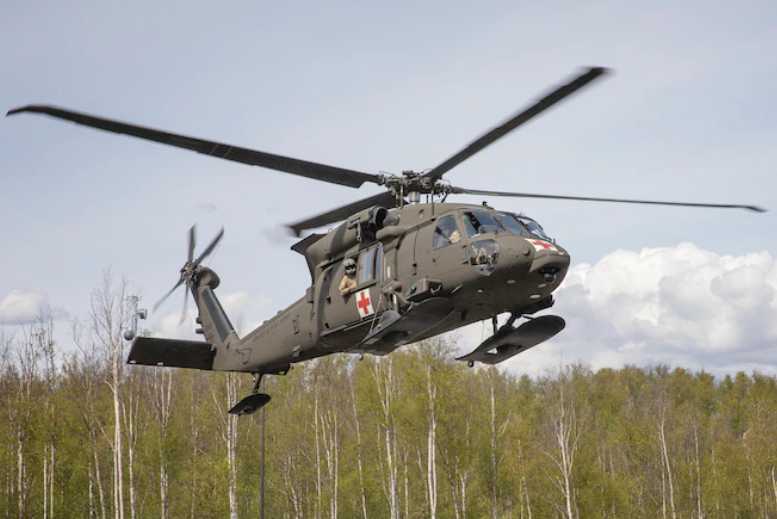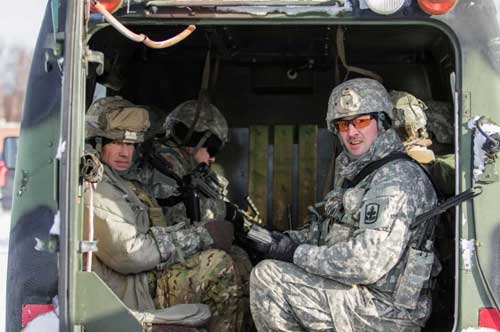
NOME, Alaska – About 530 miles northwest of Anchorage, two survey team members from the Alaska National Guard’s 103rd Weapons of Mass Destruction Civil Support Team monitor handheld detectors scanning for radiation and nerve, blister and blood agents as they prepare to enter a notional biological weapons lab at the Nome Fire Training Center as part of Exercise ORCA 2023.
ORCA is a biennial exercise to maintain readiness, validate response procedures, and collaborate with first response agencies across the state. This year’s exercise took place in Anchorage, the Matanuska-Susitna Borough, Nome and Kotzebue June 12-15.
Brightly colored, full-body suits and FBI field jackets might be out of place in the Bering Sea’s Norton Sound community, but they are essential to training for the 103rd WMD-CST and the FBI’s hazardous evidence response team.
“When we got here, we immediately grounded our gear and were ready to go,” said Warrant Officer Candidate Fabiana Kirtley, a 103rd WMD-CST survey team chief, explaining how a strike team flyaway package operates. “Our mission was to respond, mitigate and assess the hazard.”
After receiving same-day notification of a potential notional hazard, the Guardsmen and their emergency response reconnaissance vehicle rapidly deployed from Joint Base Elmendorf-Richardson to Nome via an Alaska Air National Guard C-17 Globemaster III from the 176th Wing’s 144th Airlift Squadron.
Members of FBI Anchorage and Homeland Security Investigation accompanied the CST team to the scene, a small, confined area on the second floor of a dark, dilapidated building. Extensive testing during the exercise confirmed the presence of botulism toxin and Bacillus anthracis used to make biological weapons.
“If the antigen for the specific bacteria is present, it creates an antigen-to-antibody connection and creates two lines almost like what you would see in a COVID or pregnancy test,” Kirtley said. “We complete the HHA (test) three times to rule out false positives and negatives.”
In a real incident, the samples from the field would likely be mailed back to the state lab in Anchorage for further testing and verification.
“The state lab gave us a category A sampling kit and we were able to practice packing samples to ship,” said Kirtley. “Air loading and sampling are all perishable tasks, and we need to recreate and repeat basic tasks to effectively respond to communities within our state.”
ORCA 23 brought a range of agencies together, including National Guard units from Alaska, Washington, Nebraska, Mississippi, Kansas, Ohio, Hawaii and Kentucky, eight local and state entities, three federal agencies and community partners.
Ohio National Guard Lt. Col. Katie Enochs, commander of the 52nd CST, said her team, operating in Anchorage and the Mat-Su Borough, integrated quickly with other military and civilian response teams.
“We were able to work together as a team and do joint entry,” said Enochs. “That is what is really great about doing these large-scale training exercises is working with those teammates.”
Enochs said all CST members complete a two-month course at Fort Leonard Wood, Missouri, to learn how to respond to incidents involving weapons of mass destruction. However, CST units employ different strategies and procedures.
In addition to refining interagency coordination during the chemical, biological, radiological, nuclear and explosive exercise, Enochs said bonding through the 36-hour scenario benefited her team.
Kirtley agreed that relationships built during the exercise were vital to real-world responses.
“The training opportunity here in Nome gave us the opportunity to create those connections with personnel who are on-site in these remote areas,” said Kirtley. “Every time we work with the local fire department and first responders, we enhance our response capabilities.”
[content id=”79272″]






